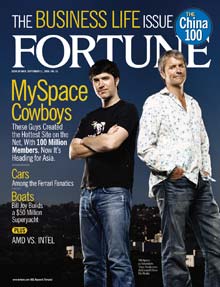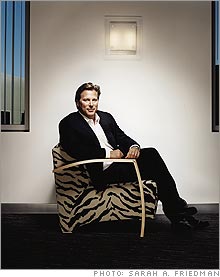Will Fox change MySpace? The question facing the MySpace founders now: Is it possible to sell out without selling out?
(Fortune Magazine) -- Tom Anderson and Chris DeWolfe founded Myspace on the principles of user control, grass-roots growth, and authenticity. "The users govern the site," DeWolfe says adamantly. But now he and Anderson have News Corp.'s financial targets to hit, a "chief revenue officer" to contend with, and serious pressure to make MySpace safe for advertisers. Already there's a backlash. Witness sightings of "Tom Is Not My Friend" T-shirts and fake Murdoch profile pages headlined FUQ RUPERT and EVIL BILLIONAIRE TYRANT!
(This is an excerpt from a longer story that appeared in the September 4 issue of Fortune. Read the full story.) When News Corp. (Charts) came knocking in June of 2005, Anderson and DeWolfe were torn. They and the board of their parent company, which had been renamed Intermix Media, needed capital to keep up with the site's torrid growth. Having lived through the dot-com bust, the money they'd make was no joke either. But the founders were wary about submerging their "anti-authority" site to, well, authority. DeWolfe told Ross Levinsohn, who heads News Corp.'s Fox Interactive Media unit, that he worried about "losing the brand, the personality, the culture." And losing it to vast, conservative News Corp., at that! "They weren't too keen on the deal," admits Murdoch. "They could get more money later, if they waited to sell. And they had a reluctance about being corporatized." A meeting in Murdoch's office on the Fox lot - at which Murdoch vowed, "We're not going to tell you how to run the site" - convinced DeWolfe it could work. Murdoch did have some ideas, though, about running the business, as Anderson - "who is nervous that we'll put him in a straitjacket," according to Murdoch - quickly learned. A few months after the acquisition, News Corp. disclosed plans to move MySpace from Santa Monica, a block from the beach, to Beverly Hills, where News Corp. was consolidating its Internet properties. Anderson and DeWolfe were horrified. Over drinks at Casa del Mar, a hotel in Santa Monica, Anderson laid out his objections to Chernin, arguing that the move would wreck the laid-back MySpace culture. "What I like about Tom is that he's so straightforward," says Chernin. "If something's bothering him, he comes right at you." Chernin listened and said he'd call in a couple of days with his decision. 'A dose of reality' "I'm a little lost," says DeWolfe. We are winding through MySpace's spanking-new headquarters in TheirSpace - the second floor of Fox Interactive's sleek gray granite office building on Maple Drive in tidy Beverly Hills. A maze of gray cubicles and red walls, the MySpace space even smells new. Compared to mellow Santa Monica, this is, well, different. There are, for example, no good lunch spots nearby, unless you walk five blocks to the Four Seasons Hotel. Not exactly a MySpace hangout. So until the Fox cafeteria opens in September, MySpace provides free boxed meals - breakfast, lunch, and dinner - to all 300 employees. Do they hate the place? No, insists DeWolfe, but he says, "We've gotten a dose of reality. We don't own the site anymore." Anderson is more candid: "Before, I could do whatever I wanted. Now it takes more time to get people to agree on things. All the budget reviews and processes. That can be a pain. But it's not stopping us." The upside, of course, is the sugar-daddy factor: that deep-pocketed parent to back your best ideas. Of the 20 new products in development, DeWolfe is particularly excited about VoIP, the 11 new international sites, and MySpace News. Several e-commerce deals - including a likely partnership with eBay (Charts) or Amazon (Charts) - are in the works, as is a MySpace Sports site and MySpace Fashion. DeWolfe and executives at Fox Interactive Media, which oversees more than 20 News Corp. Internet businesses, are also upgrading MySpace's photo- and video-storage capabilities to compete with the likes of YouTube and Yahoo's (Charts) Flickr. "Chris and Tom are adamant about trying to wage war on a feature basis rather than by blocking access (to other sites)," says Michael Barrett, FIM's chief revenue officer, who joined News Corp. from AOL in June. Wandering past warrens of tech developers, 140 of them, DeWolfe explains that a quarter of these folks are working on new features for the site. "We're hiring as many people as we can as fast as we can," he says. MySpace needs the upgrade. The site crashed for half a day in late July. Page loads have slowed dramatically, and the site, say tech bloggers, suffers from inadequate hardware and junky code. DeWolfe gets prickly about such criticism. "You could argue that MySpace pushes out features too quickly," he says, "but we also create more features than anybody else on the Internet." Under pressure to deliver profits - the business brought in just under $200 million in revenues this year and lost money after acquisition-related costs - the entrepreneurs are building MySpace's ad sales force. They're also collaborating with FIM executives to raise ad rates (an ad on MySpace's home page goes for less than Yahoo's rate of around $600,000 a day) and attract more national advertisers. MySpace already has a lot of them: Coke, Pepsi, Procter & Gamble, plus the major automakers, mobile phone carriers, and film distributors, who can't open a youth-targeted movie these days without a MySpace page. Given that MySpace is raw and bursting with sexual material, the trick is make the site feel safe for advertisers yet authentic for users. P&G, for instance, built a page for a new version of Crest toothpaste titled "Miss Irresistible." While the page has accumulated 38,267 "friends" and more than three million page views, a MySpace monitor constantly scans the page and removes raunchy "friends." Advertisers such as Honda, Unilever, and Wendy's also have posted profile pages, which sell for $100,000 and up. Two Pepsi brands, Sierra Mist and Aquafina, sponsor MySpace Comedy and MySpace Film, respectively. There are some lines DeWolfe vows never to cross. Would MySpace do pop-up ads or charge bands to promote their music? "Not as long as I'm here," he says. Levinsohn, too, appreciates that users rule on MySpace. "If we shoved professionally produced content onto MySpace, we'd be going against its charter and against everything we believe about where the Internet is going." But Murdoch and his fellow authority figures clearly want to use MySpace as a distribution arm. In mid-August the company announced plans to sell Fox TV shows and movies on MySpace, and Murdoch says he's been approached by other networks. "Whether it's a CSI or Law & Order or Desperate Housewives, we'll welcome the content." DeWolfe says he's fine with the plan - though he wants to find a way for advertisers to pay for the downloads. What, exactly, is MySpace turning into? DeWolfe says he sees it as a "lifestyle brand." But a brand has to stand for something. And with all the growth and evolution of the site, it's hard to fathom what that lifestyle even is. No question, the MySpace user base is changing. Some 87 percent of users today are 18 or older; 52 percent are 35 or older, according to comScore. Might MySpace become too big and broad and successful to be cool? One MySpace observer, Martin Sorrell, who heads ad giant WPP, believes it could: "MySpace could be like a fashion brand. The more successful you get, the more common you become." DeWolfe disagrees: "We're not deciding what's cool. Our users are," he says. "MySpace is all about letting people be what they want to be." This is an excerpt from a longer story that appeared in the September 4 issue of Fortune. Read the full story ____________________________________________ Is the rush of businesses trying to cash in on social networking sites a sign of a healthy boom? Or a fragile bubble? Tell us what you think in a Fortune Talkback forum. |
| ||||||||||||||||||


